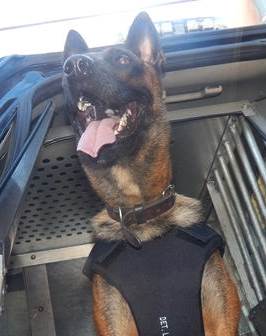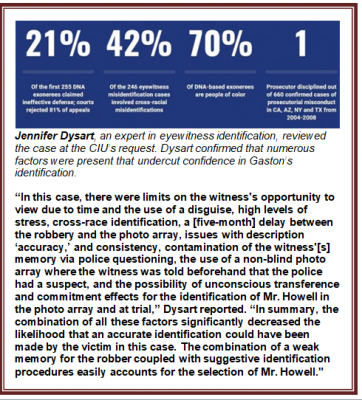2016 Conviction based on Mistaken Witness ID, False/ Misleading Forensic Evidence, Official Misconduct, Inadequate Legal Defense — NRE
Michigan Innocence Clinic researched case, presented to newly-formed Macomb County ‘Conviction Integrity Unit’
Store clerk who testified as eyewitness positively ID’s Howell, testimony called into question due to police coercion, cross-racial issue, et. al.
![]()
(Videos, photos added by Voice of Detroit.)

From left: Student-attorneys Eugene Lee and Lauren Jung, Mack Howell, student-attorney Rob Harrington, and Dave Moran, co-director of Michigan Innocence Clinic (Photo: Michigan Innocence Clinic)
By Maurice Possley
March 28, 2023
Mack Howell – National Registry of Exonerations (umich.edu)

Mack Howell (center) with nephew Dwayne Howell at right during press conference on release.
Shortly before 1 a.m. on April 3, 2014, 46-year-old Roselyn Gaston was the only employee on duty at the 7-Eleven convenience store at 10 Mile and Kelly Roads in Eastpointe, Michigan, when a man dressed in black and a ski mask covering all but his eyes burst through the front door. The man was holding a cardboard Frappuccino box in one hand which he said was covering a gun.
“Give me the money!” he shouted. “I don’t want to hurt you. I have a gun. Give me the money under the drawer.”
Gaston, who had been stacking coffee cups and lids, opened the cash register and pulled out the drawer to show that there was no money underneath the drawer. She said the man grabbed money from the drawer and ran out the front door. Gaston pressed a silent alarm and called 911.
Gaston, who was white, told police that the robber was a Black man, about 6 feet tall and weighing 180 pounds.
Among the officers who responded was Brian Dobrzycki, from the nearby Roseville police department. Dobrzycki was close by on patrol with his German Shepherd scent dog, Cato. Dobrzycki brought the dog into the store where a $20 bill had apparently been dropped by the robber. The dog circled around and was not given anything the robber had handled. The dog started tracking outside the front door which had been trafficked by police, the robber and perhaps customers.

A Roseville PD K-9 dog was used to ID ‘skin raft’ particles at 7-11 store
Several feet from the front door, next to a garbage can, the dog alerted to a paper bag. Inside the bag was a nearly empty Milwaukee’s Finest beer can with a drinking straw inserted into the opening. The dog then continued on, heading to the rear of the store where it stopped next to a concrete wall.
About 7 a.m., the owner of the 7-Eleven, Fazal Abbas, arrived. He viewed store surveillance video from the inside of the store, and created a compact disc of the 86-seconds from the entry to the exit of the robber. He turned that disc over to the police. Abbas also viewed video from an exterior camera, but did not save it, and a week later it was taped over.
Eastpointe police detective Matthew Hambright sent the paper sack, beer can and straw to the Michigan State police crime lab. A fingerprint on the beer can was deemed suitable for comparison. DNA testing was conducted on the beer can. In June, 2014, the profile of DNA found on the lip of the beer can was submitted to the FBI’s Combined DNA Index System (CODIS) and was identified as that of 53-year-old Mack Howell. The DNA profile of a female was found on the straw and could not be linked to anyone. Howell was excluded as the source of the fingerprint on the beer can.
Based on the DNA finding, Howell became the primary suspect, even though he was 5’6” tall and weighed 213 pounds.

‘Suggestive line-up’ conducted by Eastpointe P.O. Matthew Hambright
Detective Hambright would later testify that he did a frame by frame analysis of the interior store video to capture the moment when the robber left the 7-Eleven, and passed by a measuring stick next to the front door designed to help clerks assess the height of robbers.
Hambright said he compared his own height of 6’4” to the measuring stick, and determined that it was an accurate gauge. He said that based on the surveillance video, the robber was 5’6” tall. Hambright called Gaston and asked if she could be wrong about the height and weight. Hambright later testified that she said that the robber was a bit taller than her and she was 5’4 1/2 inches tall.
On September 19, 2014, Hambright took a photographic lineup to Gaston’s home. This lineup would later be criticized as suggestive. Four of the six photographs showed Black men with their eyes half-closed. The other two – Howell, who was in the #1 position, and another Black man, who was in the #5 position – had brighter eyes.
 After looking at the photographs, Gaston selected #5, who was a filler. Hambright asked, “Are you sure?” Gaston said she was not. Hambright asked her to look again. Gaston used her fingers to cover up all of the faces of the individuals in the lineup so that only their eyes were visible. She then selected Howell, and said she was 100 percent sure that he was he robber.
After looking at the photographs, Gaston selected #5, who was a filler. Hambright asked, “Are you sure?” Gaston said she was not. Hambright asked her to look again. Gaston used her fingers to cover up all of the faces of the individuals in the lineup so that only their eyes were visible. She then selected Howell, and said she was 100 percent sure that he was he robber.
Nearly a year later, on August 7, 2015, Howell was arrested. During questioning, he denied being involved in the robbery. He was charged with armed robbery.
At a preliminary hearing in September 2015, Gaston, who was 5’4” tall, changed her description of the robber. She said the robber was 5’8” tall and had a “medium build.” She said she was 100 percent certain of her identification of Howell.

Trial Judge Edward Servitto
On August 23, 2016, Howell went to trial in Macomb County Circuit Court. Gaston testified and again said she was 100 percent sure that Howell was the robber. She said she would “never forget” the robber’s eyes.
Abbas, the owner of the 7-Eleven, testified that he viewed the surveillance video of the exterior of the store. He said the robber stopped briefly at the dumpsters and then continued to the rear of the property. He said he did not provide the video to the police because no one asked him for it. He also said the video quality was not good enough to identify the robber.
Dobrzycki testified about how he and his “canine partner,” Cato, came to the scene. He said he brought the dog into the store where the dog “scented” into the area. Asked by the prosecutor, Sunita Doddamani, to explain, Dobrzycki said, “People drop skin rafts when they are doing something; when their adrenaline is going, they drop more skin rafts [than] a normal person that walks around.” “What’s a skin raft?” Doddamani asked.

Trial AP Sunita Doddamani
“It’s skin follicles that actually fall that you can’t even see from your body,” Dobrzycki said. “The skin rafts are falling from everyone’s body on an everyday basis, and when you’re doing something you’re not supposed to, you’re dropping more than…a normal person.”
Howell’s defense attorney, Arlene Woods, objected, arguing that Dobrzycki was not qualified to testify about skin droppings. Judge Edward Servitto Jr. agreed. “Under certain circumstances he’s not qualified to say that more droppings are going to occur under certain circumstances, but otherwise there are droppings from the human body, the dog’s olfactory has the ability to pick up those rafts,” the judge said.
Dobrzycki testified that the dog was allowed to roam inside the store where the robbery occurred and then was taken to the front door. Tracking began just outside the front door, Dobrzycki said. “He begins tracking…and he, what we call downs or alerts on a beverage container that’s right outside the front door.”
“What do you mean to down and alert?” Doddamani asked.
“He is basically telling me that [it] has fresh human odor and that’s part of the track,” Dobrzycki testified. The dog will actually lie down with its front paws in front of the alerted item, Dobrzycki said. “He’ll just down until we tell him to begin to track again from that item.”
Dobrzycki said the dog went to the corner of the store, and then went to the rear, past some dumpsters and into a parking lot. “We continue almost to the back wall and he, what we call, begins scent loss.” The track was over at that point, Dobrzycki said.
Sgt. Cynthia Edwards from the Michigan State Police crime laboratory said she compared the fingerprint on the beer can to Howell and excluded him as the source of that fingerprint. She said two other fingerprints from inside the store were not of sufficient quality for comparison. She said the result of her comparison with Howell’s fingerprints was “inconclusive.”
The defense and prosecution stipulated that Howell’s DNA was found on the lip of the beer can. The defense noted there was no evidence as to how Howell’s DNA got on the can or when the can came to be outside the store.
Hambright testified and described how he administered the photographic lineup. He denied that he was trying to influence Gaston when he asked her if she was sure when initially selected the filler in position #5 as the robber.
He also described how he compared the surveillance video to the store’s measuring stick to conclude that the robber was 5’6” tall, not the 6’ that Gaston had described. Hambright said he did not submit the Frappuccino box, which was found near the dumpsters, or the $20 bill to the crime lab for examination because he did not consider those items to likely have evidentiary value.
Woods called two alibi witnesses who said that Howell was home on the night of the crime – a distance of about three miles from the 7-Eleven, and that he did not have access to a car.
Dr. Colleen Seifert, a professor of psychology at the University of Michigan, testified as an expert in memory. She told the jury that several factors were present that could lead to an erroneous identification. These included the short duration of the crime, the fact that Gaston was white and the robber was black, the passage of several months between the crime and the identification, and that Hambright knew who the suspect was and likely influenced Gaston’s selection.
On August 29, 2016, the jury convicted Howell of armed robbery. He was sentenced to 25 to 50 years in prison.
In February 2018, the Michigan Court of Appeals affirmed the conviction. Howell, acting without a lawyer, filed a federal petition for a writ of habeas corpus in 2019. The petition was denied.
In the meantime, in 2018, the Innocence Clinic at the University of Michigan Law School had begun re-investigating the case on Howell’s behalf.
The Innocence Clinic consulted with two photogrammetry experts. Eugene Levin, an associate professor of Geospatial Engineering at Michigan Technological University, opined that based on his examination of the internal store video and measurements taken inside the store, the robber was 5’10” tall, plus or minus an inch. Sorin Popescu, a professor of Remote Sensing at Texas A&M University, reported that he believed the robber was approximately 5’8” tall.
The Innocence Clinic found Howell’s medical records which showed that during 2013-2014, Howell saw his primary care doctor almost monthly. As early as January 13, 2013, records show Howell had long-standing pain down both legs, worse with activity or movement, and that he used a cane. The records also showed that his leg pain, particularly on the right, was steadily worsening. Four days after the robbery, he was seen by his doctor and a workup began to determine a diagnosis. On September 30, 2014, Howell had the first of six procedures to open very significant arterial blockages in his right and left legs. A previously-rejected Supplemental Security Income claim for disability was approved on January 8, 2015, with a finding of disabling “peripheral vascular disease.” The disability claim was dated to September 24, 2014, the date the application was filed.
 Dr. James Ha, an emeritus research professor at the University of Washington and a certified applied animal behaviorist, examined the evidence and concluded that the “hit” by Cato on the paper bag-covered beer can “is not at all sufficient to prove the paper bag or its contents were connected to the suspect.” A “dog’s behavior, even if the dog is well trained and well handled, is too prone to error to itself be scientifically valid evidence,” Dr. Ha reported.
Dr. James Ha, an emeritus research professor at the University of Washington and a certified applied animal behaviorist, examined the evidence and concluded that the “hit” by Cato on the paper bag-covered beer can “is not at all sufficient to prove the paper bag or its contents were connected to the suspect.” A “dog’s behavior, even if the dog is well trained and well handled, is too prone to error to itself be scientifically valid evidence,” Dr. Ha reported.
Further, “dog tracking is most reliable when the dog starts its track where the suspect lingered for an extended period of time.” This is especially the case when the track starts at a place that is usually “heavily trafficked.” The in-store video showed Gaston walking through the store and police may have done so as well “which contaminated the scene.”
In 2022, the Macomb County Prosecutor’s Office created a Conviction Integrity Unit (CIU). At the request of the Innocence Clinic, Howell’s case became the first one to be examined by the CIU.
Jennifer Dysart, an expert in eyewitness identification, reviewed the case at the CIU’s request. Dysart confirmed that numerous factors were present that undercut confidence in Gaston’s identification.
“In this case, there were limits on the witness’s opportunity to view due to time and the use of a disguise, high levels of stress, cross-race identification, a [five-month] delay between the robbery and the photo array, issues with description ‘accuracy,’ and consistency, contamination of the witness'[s] memory via police questioning, the use of a non-blind photo array where the witness was told beforehand that the police had a suspect, and the possibility of unconscious transference and commitment effects for the identification of Mr. Howell in the photo array and at trial,” Dysart reported. “In summary, the combination of all these factors significantly decreased the likelihood that an accurate identification could have been made by the victim in this case. The combination of a weak memory for the robber coupled with suggestive identification procedures easily accounts for the selection of Mr. Howell.”
During its investigation, the CIU discovered that between April 2014 and August 2014, there were armed robberies that took place at several 7-Elevens in south Macomb County. They included:
–On July 16, August 10 and August 15, 2014, there were three armed robberies of the same 7-Eleven located on 10 Mile Road in Warren, Michigan, about 2 miles east of the 7-Eleven that Howell was convicted of robbing.
–On July 25, 2014, a 7-Eleven in St. Clair Shores, about three miles south, was the victim of an armed robbery.
–On August 8, 2014, the same 7-Eleven that Howell was convicted of robbing was robbed again.
The CIU noted that these robberies were located fairly close together and all involved a robber who was masked and ungloved – as Gaston had described. The robber displayed a gun in all but one of those robberies, wore eyeglasses in some of them, and always was on foot. Many of the facts were similar to the April 3, 2014, armed robbery for which Howell was convicted.

Macomb County CIU Director Gail Pamukov
The CIU’s investigation revealed that prior to Howell’s arrest, a man was charged with all of those robberies. The defendant, who was 5’ 10’ tall and 170 pounds, confessed to the robberies on August 20, 2014, pled no contest to the five robberies on May 28, 2015, and was sentenced – all prior to Howell’s trial. None of that information was known to Howell’s defense attorney at the time of his trial.
On March 20, 2023, a joint motion was filed by David Moran, co-director of the Innocence Clinic, and Gail Pamukov, CIU chief, requesting that Howell’s conviction be vacated. The motion said, “The Macomb County Prosecutor’s Office supports the dismissal and vacating of Mr. Howell’s conviction and sentence since the discovery of new evidence severely compromises the primary evidence of guilt.”
The motion was granted, the case was dismissed, and Howell was released that day.
RELATED:
‘It’s amazing’ says man freed from prison for robbery he didn’t commit (freep.com)
“Howell is the first person to be exonerated by the Conviction Integrity Unit of the Macomb County Prosecutor’s Office, formed last year and led by Gail Pamukov. The unit is one of a handful across Michigan.
She said her office has received 50 to 60 applications for convictions to review. The process takes months just to gather documents, conduct an investigation and determine whether there is validity to show a conviction is wrong.”




